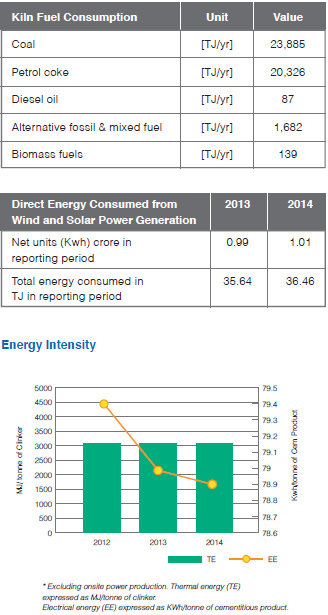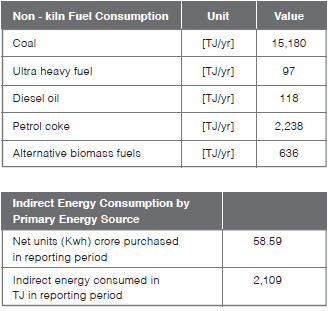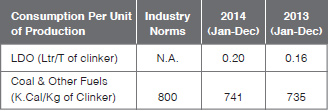Power and fuel costs account for approximately 26% of
the total operating cost of the Company. Coal cost for kilns
and captive power plants increased by 4% and 10%
respectively, mainly due to the higher cost of imported coal.
However, substitution of high cost coal by petcoke helped in
restricting the overall cost increase. Besides, there was
increased use of alternative fuels as compared to the
previous year. Use of alternative fuels accounted for four
per cent of the total thermal energy consumption in 2014.
The cost of grid power remained stable on a per unit basis.
However, the cost of captive power increased by 10% in
2014 mainly due to the higher coal prices. Captive power
generation contributed 67% of the total power requirement.
Overall, power and fuel costs increased by seven per cent
per tonne as compared to the year 2013. Depleting coal
Direct Energy Consumption by Primary Energy Source in TJ/Yr.
 |
linkages and volatility in the Indian rupee are escalating
concerns regarding coal. The Company is constantly
working on efficiency improvement measures by plugging
heat losses at every possible stage of coal consumption. In
addition, it is seriously looking at cost-effective fuel mixes and
increasing the use of alternative fuels and petcoke. As a long
term solution to energy security, the Company has invested
in Project Geocycle, under the banner of ‘Geo 20’. Waste
heat recovery (WHR) systems that improve fuel utilisation
by tapping renewable energy sources are given top
priority. New AFR pre-processing platforms have been
installed at our plant locations to increase the use of AFR.
Use of biomass is another focus area for Ambuja but its
seasonal availability & rising price have been a limiting factor.
 Ambuja continuously does its best to reduce the power,
LDO, coal and other fuels consumed per unit of
cement produced. Ambuja continuously does its best to reduce the power,
LDO, coal and other fuels consumed per unit of
cement produced.

Currently industry standards for energy requirement for
the use of cement at user level are not prevalent. Ambuja
attention to adopt best practices. |
























 Ambuja continuously does its best to reduce the power,
LDO, coal and other fuels consumed per unit of
cement produced.
Ambuja continuously does its best to reduce the power,
LDO, coal and other fuels consumed per unit of
cement produced.

